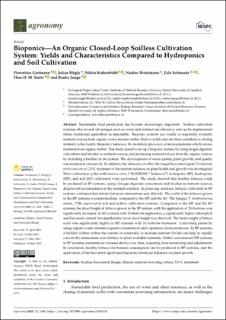Please use this identifier to cite or link to this item:
https://doi.org/10.21256/zhaw-27913| Publication type: | Article in scientific journal |
| Type of review: | Peer review (publication) |
| Title: | Bioponics – an organic closed-loop soilless cultivation system : yields and characteristics compared to hydroponics and soil cultivation |
| Authors: | Gartmann, Florentina Hügly, Julian Krähenbühl, Nikita Brinkmann, Nadine Schmautz, Zala Smits, Theo H. M. Junge, Ranka |
| et. al: | No |
| DOI: | 10.3390/agronomy13061436 10.21256/zhaw-27913 |
| Published in: | Agronomy |
| Volume(Issue): | 13 |
| Issue: | 6 |
| Page(s): | 1436 |
| Issue Date: | 2023 |
| Publisher / Ed. Institution: | MDPI |
| ISSN: | 2073-4395 |
| Language: | English |
| Subjects: | Biochar; Biocontrol; Biogas effluent; Nutrient recycling; Lettuce; UV-C treatment; Biokohle; Biogas-Nährstoffkonzentrat; Pflanzenschutz; Salat; UV-C Behandlung; UV-C Licht |
| Subject (DDC): | 630: Agriculture |
| Abstract: | Sustainable food production has become increasingly important. Soilless cultivation systems offer several advantages, such as water and nutrient use efficiency, and can be implemented where traditional agriculture is impossible. Bioponic systems use locally or regionally available nutrient sources from organic waste streams (either fluid or solid) and can thus contribute to closing nutrient cycles locally. Bioponics harnesses the metabolic processes of microorganisms which release nutrients from organic matter. This study aimed to set up a bioponic system, by using biogas digestate concentrate and biochar as nutrient sources, and promoting nutrient release from the organic sources by including a biofilter in the system. The development of water quality, plant growth, and quality was monitored extensively. In addition, the influence of either the fungal biocontrol agent Trichoderma atrobrunneum or UV-C treatment of the nutrient solution on plant health and growth was investigated. Three cultivation cycles with Lactuca sativa (“HAWKING” Salanova®) in bioponic (BP), hydroponic (HP), and soil (SO) cultivation were performed. The study showed that healthy lettuces could be produced in BP systems, using a biogas digestate concentrate and biochar as nutrient sources, despite salt accumulation in the nutrient solution. In plant sap analyses, lettuces cultivated in BP systems contained less nitrate but more ammonium and chloride. The yield of the lettuces grown in the BP systems was intermediate, compared to the HP and the SO. The fungus, T. atrobrunneum, strain, T720, survived in soil and soilless cultivation systems. Compared to the HP and the SO systems, the shoot height of lettuces grown in the BP system, with the application of Trichoderma, was significantly increased. In SO systems with Trichoderma application, a significantly higher chlorophyll and flavonoid content, but significantly lower shoot height was observed. The fresh weight of lettuce roots was significantly higher in HP systems with Trichoderma treatment. Cultivating plants by using organic waste streams requires commitment and experience from producers. In BP systems, a biofilter (either within the system or externally, to increase nutrient levels) can help to rapidly convert the ammonium-rich fertilizer to plant-available nutrients. Unlike conventional HP systems, in BP systems, nutrients are released slowly over time, requiring close monitoring and adjustments. In conclusion, healthy lettuces for human consumption can be produced in BP systems, and the application of the biocontrol agent used has some beneficial influence on plant growth. |
| URI: | https://digitalcollection.zhaw.ch/handle/11475/27913 |
| Fulltext version: | Published version |
| License (according to publishing contract): | CC BY 4.0: Attribution 4.0 International |
| Departement: | Life Sciences and Facility Management |
| Organisational Unit: | Institute of Natural Resource Sciences (IUNR) |
| Appears in collections: | Publikationen Life Sciences und Facility Management |
Files in This Item:
| File | Description | Size | Format | |
|---|---|---|---|---|
| 2023_Gartmann-etal_Bioponics-an-organic-closed-loop-soilless-cultivation-system_agronomy.pdf | 3.69 MB | Adobe PDF |  View/Open |
Show full item record
Gartmann, F., Hügly, J., Krähenbühl, N., Brinkmann, N., Schmautz, Z., Smits, T. H. M., & Junge, R. (2023). Bioponics – an organic closed-loop soilless cultivation system : yields and characteristics compared to hydroponics and soil cultivation. Agronomy, 13(6), 1436. https://doi.org/10.3390/agronomy13061436
Gartmann, F. et al. (2023) ‘Bioponics – an organic closed-loop soilless cultivation system : yields and characteristics compared to hydroponics and soil cultivation’, Agronomy, 13(6), p. 1436. Available at: https://doi.org/10.3390/agronomy13061436.
F. Gartmann et al., “Bioponics – an organic closed-loop soilless cultivation system : yields and characteristics compared to hydroponics and soil cultivation,” Agronomy, vol. 13, no. 6, p. 1436, 2023, doi: 10.3390/agronomy13061436.
GARTMANN, Florentina, Julian HÜGLY, Nikita KRÄHENBÜHL, Nadine BRINKMANN, Zala SCHMAUTZ, Theo H. M. SMITS und Ranka JUNGE, 2023. Bioponics – an organic closed-loop soilless cultivation system : yields and characteristics compared to hydroponics and soil cultivation. Agronomy. 2023. Bd. 13, Nr. 6, S. 1436. DOI 10.3390/agronomy13061436
Gartmann, Florentina, Julian Hügly, Nikita Krähenbühl, Nadine Brinkmann, Zala Schmautz, Theo H. M. Smits, and Ranka Junge. 2023. “Bioponics – an Organic Closed-Loop Soilless Cultivation System : Yields and Characteristics Compared to Hydroponics and Soil Cultivation.” Agronomy 13 (6): 1436. https://doi.org/10.3390/agronomy13061436.
Gartmann, Florentina, et al. “Bioponics – an Organic Closed-Loop Soilless Cultivation System : Yields and Characteristics Compared to Hydroponics and Soil Cultivation.” Agronomy, vol. 13, no. 6, 2023, p. 1436, https://doi.org/10.3390/agronomy13061436.
Items in DSpace are protected by copyright, with all rights reserved, unless otherwise indicated.